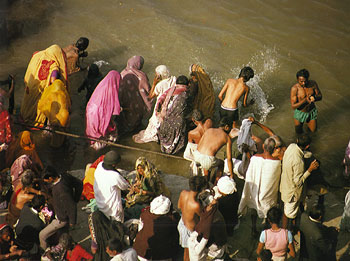
Besides the ganges, there are two other sacred rivers located at Allahabad—the yamuna and the saraswati. The yamuna, like the ganges, has its earthly origin in the himalayas. The saraswati, however, is a mystical river which has no physical form. It is believed that the saraswati exists only on the ethereal or spiritual plane and is invisible to the human eye. This holy river is mentioned repeatedly in India's sacred texts like the Mababharata and is said to be present at Allahabad where it joins the yamuna and the ganges. This confluence of India's three most sacred rivers is called the sangam.
The highlight for most pilgrims during a Kumbha Mela festival is the observance of a holy bath at the sangam. A holy bath in either of the sacred rivers has purifying effects, but where the three rivers meet, the purification is said to increase one hundred times. It is further believed that when one takes a sacred bath at the sangam during the Kumbha Mela, the potency of the holy water is increased one thousand times. For this reason, Indians believe that the Kumbha Mela is the most auspicious place in the universe to take a holy bath. Armed with this faith, pilgrims attend Kumbha Mela and bathe in the Ganges in a mood of solemn reverence.
The American poet Mark Twain expressed his wonder at the faith of the pilgrims at the Kumbha Mela when he wrote in More Tramps Abroad (1895): "These pilgrims had come from all over India: some of them had been months on the way, plodding patiently along in the heat and dust, worn and poor, hungry, but supported and sustained by an unwavering faith and belief. It is wonderful, that the power of faith like that can make multitude upon multitudes of the old and weak and the young and frail enter without hesitation or complaint upon such incredible journeys and endure the resultant miseries without repining."
